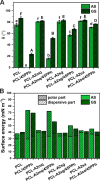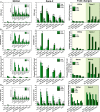Bioactive Glasses Modulate Anticancer Activity and Other Polyphenol-Related Properties of Polyphenol-Loaded PCL/Bioactive Glass Composites
- PMID: 38709741
- PMCID: PMC11103658
- DOI: 10.1021/acsami.4c02418
Bioactive Glasses Modulate Anticancer Activity and Other Polyphenol-Related Properties of Polyphenol-Loaded PCL/Bioactive Glass Composites
Abstract
In this work, bioactive glass (BG) particles obtained by three different methods (melt-quenching, sol-gel, and sol-gel-EISA) were used as modifiers of polyphenol-loaded PCL-based composites. The composites were loaded with polyphenolic compounds (PPh) extracted from sage (Salvia officinalis L.). It was hypothesized that BG particles, due to their different textural properties (porosity, surface area) and surface chemistry (content of silanol groups), would act as an agent to control the release of polyphenols from PCL/BG composite films and other significant properties associated with and affected by the presence of PPh. The polyphenols improved the hydrophilicity, apatite-forming ability, and mechanical properties of the composites and provided antioxidant and anticancer activity. As the BG particles had different polyphenol-binding capacities, they modulated the kinetics of polyphenol release from the composites and the aforementioned properties to a great extent. Importantly, the PPh-loaded materials exhibited multifaceted and selective anticancer activity, including ROS-mediated cell cycle arrest and apoptosis of osteosarcoma (OS) cells (Saos-2) via Cdk2-, GADD45G-, and caspase-3/7-dependent pathways. The materials showed a cytotoxic and antiproliferative effect on cancerous osteoblasts but not on normal human osteoblasts. These results suggest that the composites have great potential as biomaterials for treating bone defects, particularly following surgical removal of OS tumors.
Keywords: anticancer activity; bioactive glass; bone substitute; composite; drug delivery; plant extract; polyphenols.
Conflict of interest statement
The authors declare no competing financial interest.
Figures








Similar articles
-
PCL and PCL/bioactive glass biomaterials as carriers for biologically active polyphenolic compounds: Comprehensive physicochemical and biological evaluation.Bioact Mater. 2020 Dec 5;6(6):1811-1826. doi: 10.1016/j.bioactmat.2020.11.025. eCollection 2021 Jun. Bioact Mater. 2020. PMID: 34632164 Free PMC article.
-
In vitro/in vivo biocompatibility and mechanical properties of bioactive glass nanofiber and poly(epsilon-caprolactone) composite materials.J Biomed Mater Res B Appl Biomater. 2009 Oct;91(1):213-20. doi: 10.1002/jbm.b.31392. J Biomed Mater Res B Appl Biomater. 2009. PMID: 19422050
-
New generation poly(ε-caprolactone)/gel-derived bioactive glass composites for bone tissue engineering: Part I. Material properties.Mater Sci Eng C Mater Biol Appl. 2015 Nov 1;56:9-21. doi: 10.1016/j.msec.2015.06.020. Epub 2015 Jun 11. Mater Sci Eng C Mater Biol Appl. 2015. PMID: 26249560
-
Mechanical properties of bioactive glasses, ceramics, glass-ceramics and composites: State-of-the-art review and future challenges.Mater Sci Eng C Mater Biol Appl. 2019 Nov;104:109895. doi: 10.1016/j.msec.2019.109895. Epub 2019 Jun 16. Mater Sci Eng C Mater Biol Appl. 2019. PMID: 31500047 Review.
-
Polyphenol nanoformulations for cancer therapy: experimental evidence and clinical perspective.Int J Nanomedicine. 2017 Apr 4;12:2689-2702. doi: 10.2147/IJN.S131973. eCollection 2017. Int J Nanomedicine. 2017. PMID: 28435252 Free PMC article. Review.
References
MeSH terms
LinkOut - more resources
Full Text Sources
Research Materials

